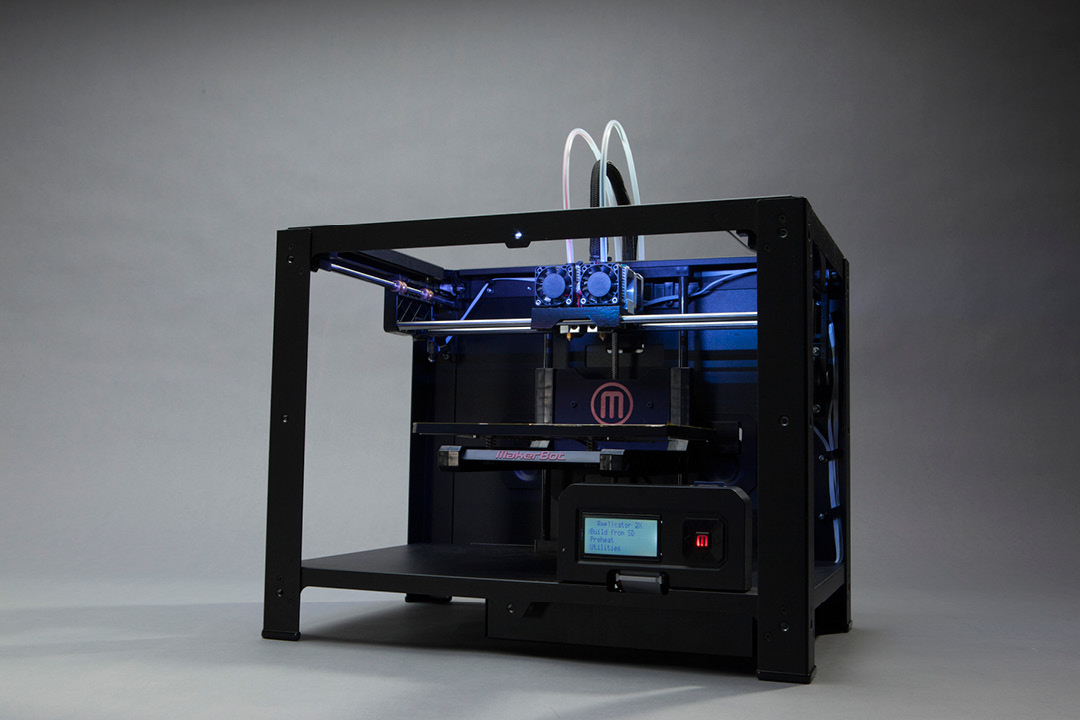
It could almost be considered ironic that MakerBot printers like the Replicator 2X that owe their existence to Stratasys’ FDM technology have returned to the fold. Courtesy of MakerBot.
July 23, 2013
The first big wave of expansion in the digital manufacturing revolution came thanks to the expiration of patents related to Stratasys’ Fused Deposition Modeling (FDM) process. This gave companies such as MakerBot the freedom to design, develop and manufacture 3D printers that used similar material extrusion technology, and offer them for sale to hobbyists at much lower prices than comparable professional additive manufacturing (AM) systems.
2014 marks the end of a number of other patents on AM processes, such as laser sintering (ASTM powder bed fusion), which could very well mark the second revolution in the industry. While it took years for the material extrusion printers to really hit the market, that was prior to the sort of exposure AM has today. This second wave of expansion could come much more quickly, and have the potential to bring higher quality prints to a broader range of customers.
It may be true the US patent system has its share of problems, but it does, in general, allow companies to profit from research breakthroughs for a reasonable amount of time (usually around 20 years). The problem in a world economy is that not every country is willing to abide by the same rules on patents. China, who is notorious for its indifference to patents, has been making a big push in AM. Along with the US and Europe, China is a serious contender in the race to determine who will be the 3D printer powerhouse of the future.
This is what Tim Caffrey from Wohlers Associates had to say about the global AM race:
In today’s global, inter-connected economy, governments have become aware of the importance of a domestic manufacturing infrastructure to underpin a healthy economic system. It is no surprise that these same governments see the development of advanced manufacturing technologies as a way to gain a competitive advantage in the attempt to grow that manufacturing infrastructure.For better or worse, additive manufacturing (AM) has become the “poster child” of the advanced manufacturing technologies, especially since it was mentioned by President Obama in his February State of the Union address. His comments appear to have had an unintended consequence: they stimulated the Chinese and British governments (and others) to invest quickly in advanced manufacturing in general, and AM in particular.
Without a level playing field, China could easily become the dominant producer of AM systems throughout the world. The expiration of these patents has the potential to increase US competitiveness by broadening the base of manufacturers. As it now stands, 3D Systems, owner of many of the patents in question, is simply unable to keep up with demand for its products. An order placed today for some of its products will get filled in anywhere from 12 to 18 months, according to Quartz. Customers who aren’t willing to wait a year or more for a 3D printer are bound to seek out alternative markets.
Another facet of AM that may well be improved by patent expiration is that of public perception. Currently when talking to people outside the 3D printing industry about the technology, the most frequent concern I hear raised is that of quality. This notion has arisen, no doubt, from the slew of low cost material extrusion systems on the market. While you might be able to purchase a 3D printer for $300, that system is likely to come with some pretty chunky strata lines.
Laser sintering is a smoother process (in the main) than material extrusion. Objects that are dusted off after being pulled from a powder bed look much more like what people expect from a finished product, without requiring some sort of refining process. The issue with laser sintering systems and a more general adoption is the price. Most of these systems are well beyond the means of the average consumer and many small businesses. More laser sintering manufacturers should bring about the same sort of price decrease as was seen for material extrusion.
Below you’ll find a clip about patent expiration in AM.
Source: Quartz
Subscribe to our FREE magazine, FREE email newsletters or both!
About the Author
John NewmanJohn Newman is a Digital Engineering contributor who focuses on 3D printing. Contact him via [email protected] and read his posts on Rapid Ready Technology.
Follow DERelated Topics







